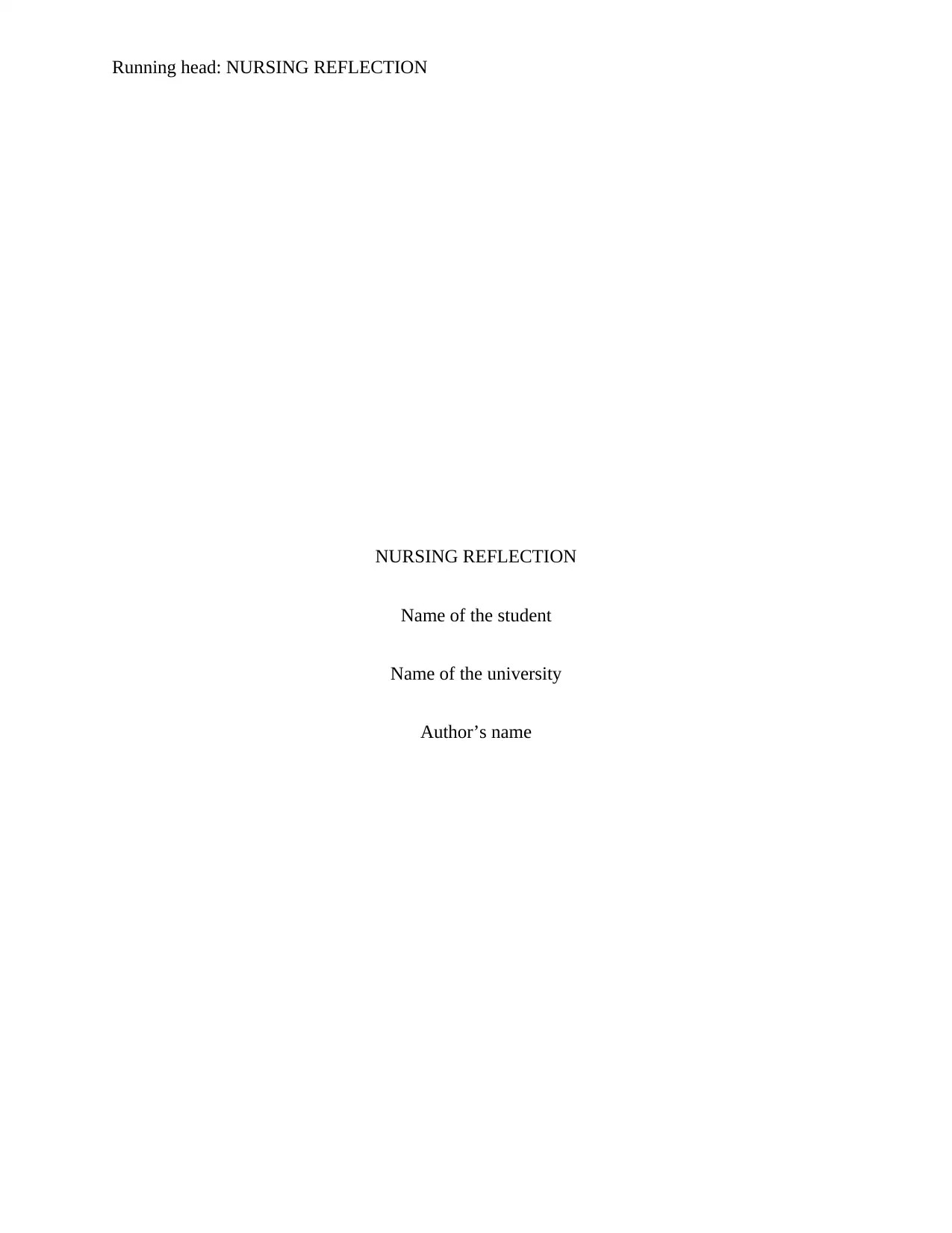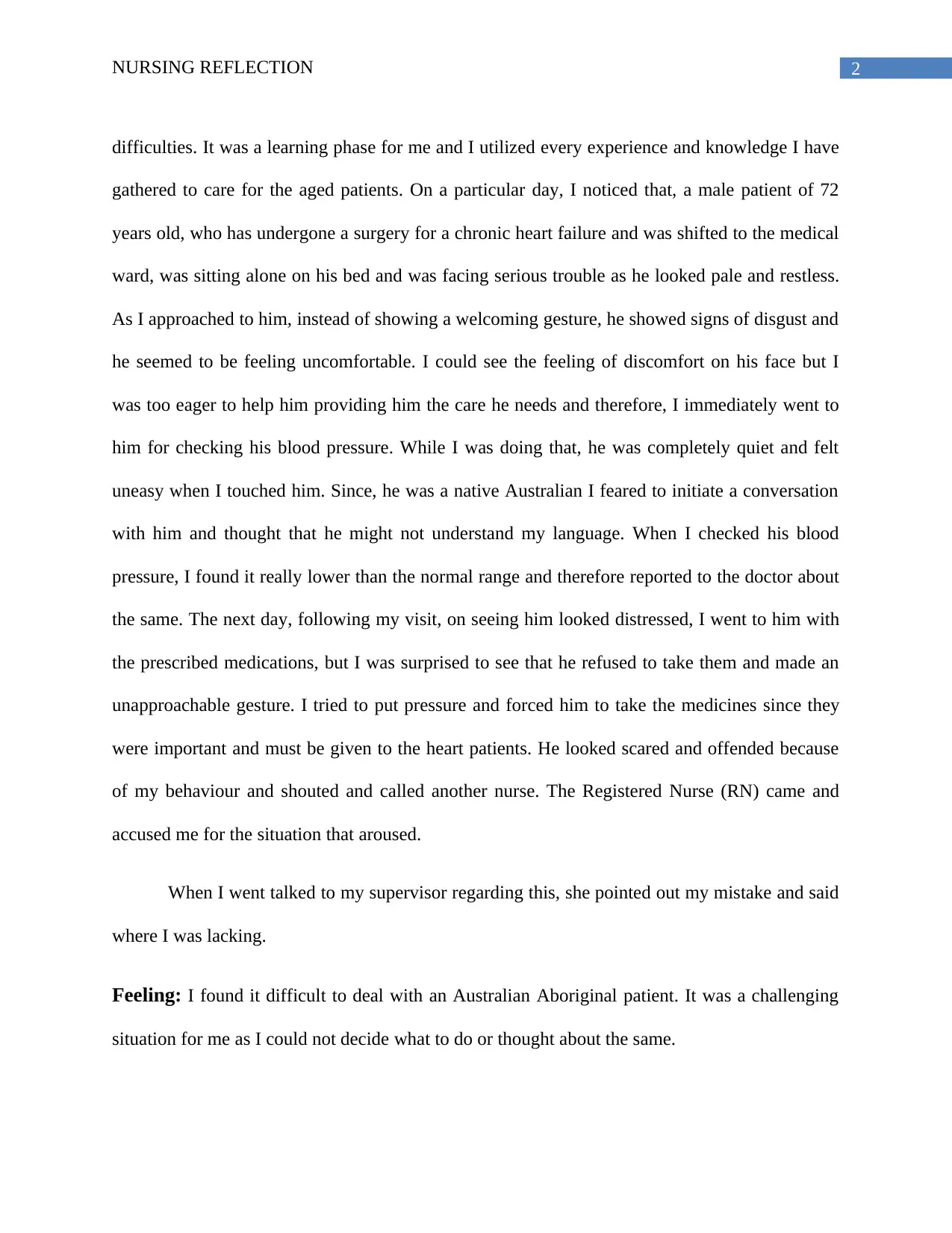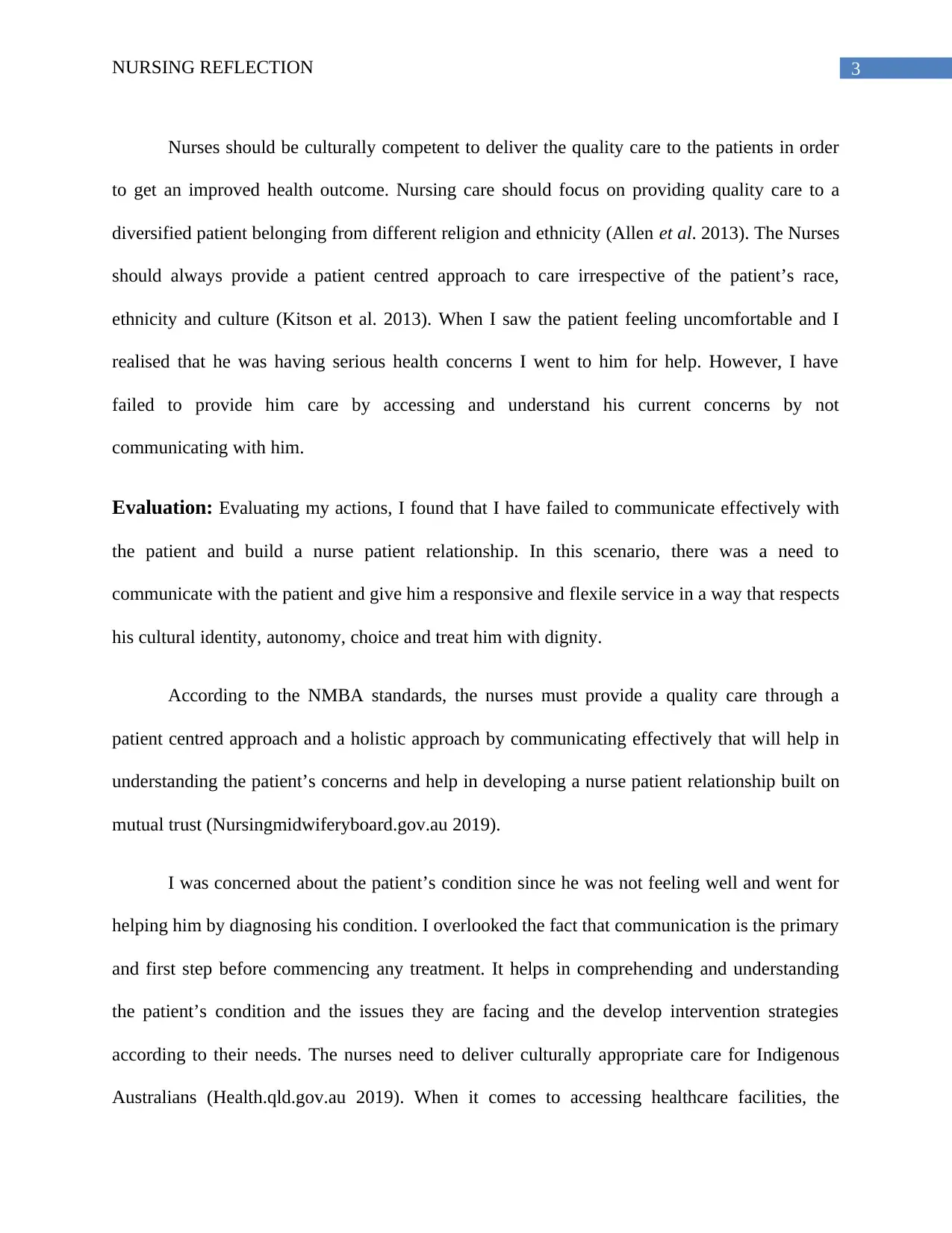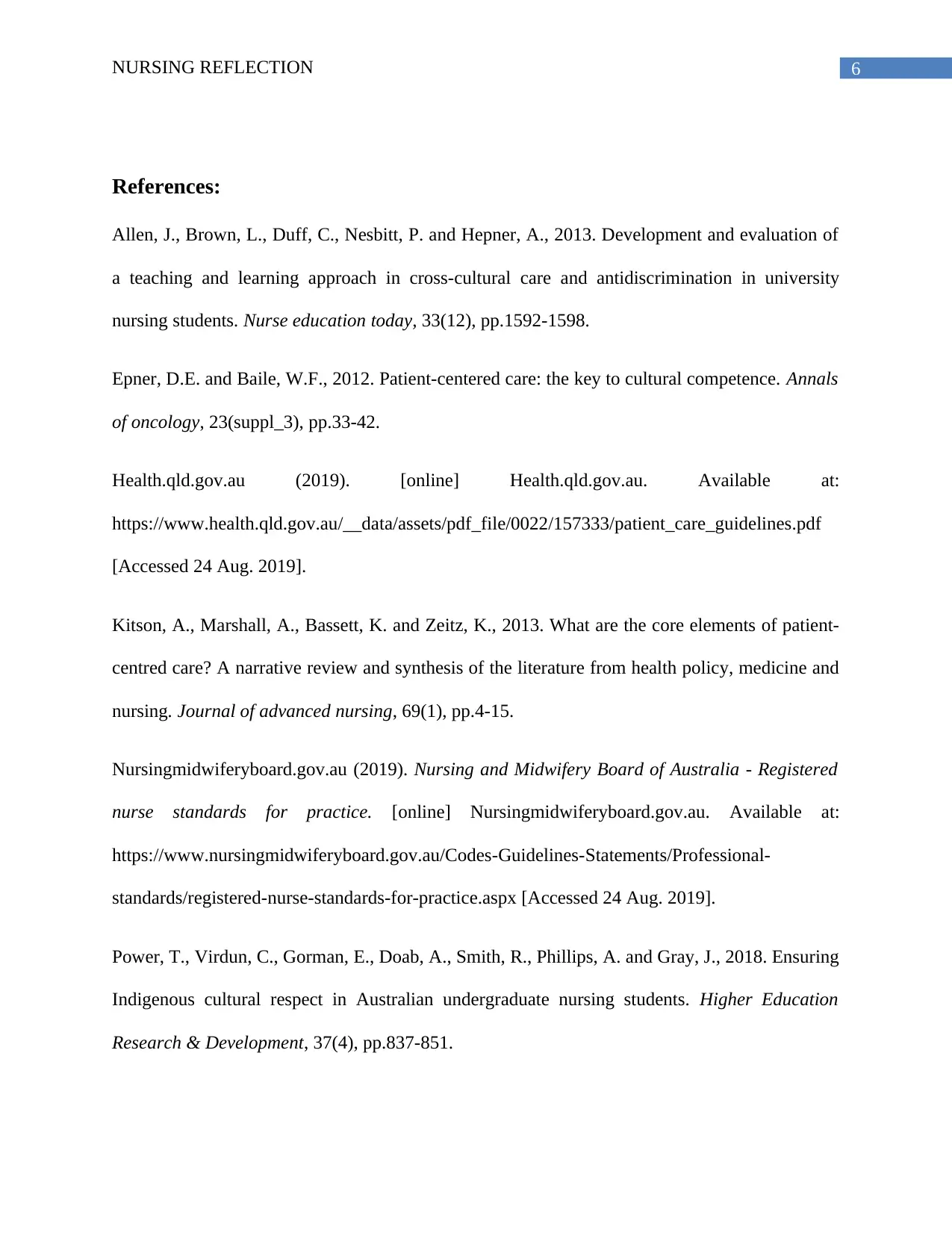Nursing Reflection: Cultural Competency in Aged Care Setting
VerifiedAdded on 2022/09/17
|7
|1628
|32
Essay
AI Summary
This nursing reflection essay details a student's experience in an aged care facility, focusing on the importance of cultural competency and effective communication in providing quality patient care. The essay utilizes Gibb's Reflective Cycle to analyze a specific incident involving an Australian Aboriginal patient who was resistant to care. The reflection highlights the student's initial missteps in communication and the resulting negative patient response. It then evaluates the situation, analyzing the failure to adhere to nursing standards, particularly regarding patient-centered care and cultural sensitivity. The essay emphasizes the need for improved interpersonal skills and a deeper understanding of cultural differences to provide holistic care. The student concludes with an action plan to enhance communication skills and incorporate a patient-centered approach in future clinical placements, aligning with the Nursing and Midwifery Board of Australia's standards. The essay underscores the significance of addressing patients' cultural, emotional, and spiritual needs to improve health outcomes and patient satisfaction.

Running head: NURSING REFLECTION
NURSING REFLECTION
Name of the student
Name of the university
Author’s name
NURSING REFLECTION
Name of the student
Name of the university
Author’s name
Paraphrase This Document
Need a fresh take? Get an instant paraphrase of this document with our AI Paraphraser

1NURSING REFLECTION
Introduction:
Providing care to the patients by being culturally competent through a patient centred
approach can improve the quality of care given as well as create an understanding of health care
among populations who are culturally diverse and encourage a holistic approach to care
promoting the health outcome of the patients and thereby increasing patient’s satisfaction.
Despite the fact that there are nursing standards stating the guidelines of the nursing practices,
the Australian Aboriginals and those who are culturally diverse faces health disparity
(Health.qld.gov.au 2019). Cultural competence encourages a more holistic approach to care by
facilitating patient centred approach and care by building a nurse patient relationship to achieve
the desired outcome (Health.qld.gov.au 2019). Evidences have shown the prevalence of
morbidity and mortality in the culturally diverse patients to be greater because of their
inaccessibility of the health services due to their diverse cultural, social and linguistic needs
(Allen et al. 2013). The paper is a reflection on the experiences I had during my clinical
placement in an aged care facility and the skills and facts I have learnt from the situation on the
importance of interpersonal skills and cultural competency in providing quality care to the
patients. I have used Gibb’s Reflective cycle for writing the reflection since it has several
sections describing the stages of my experience including the knowledge I have gained and the
action plan to prepare myself if the situation arises again.
Discussion
Description: During my clinical placement I was allocated in an aged care facility. I was
working under the supervision of the senior nurse manager who guided me whenever I faced any
Introduction:
Providing care to the patients by being culturally competent through a patient centred
approach can improve the quality of care given as well as create an understanding of health care
among populations who are culturally diverse and encourage a holistic approach to care
promoting the health outcome of the patients and thereby increasing patient’s satisfaction.
Despite the fact that there are nursing standards stating the guidelines of the nursing practices,
the Australian Aboriginals and those who are culturally diverse faces health disparity
(Health.qld.gov.au 2019). Cultural competence encourages a more holistic approach to care by
facilitating patient centred approach and care by building a nurse patient relationship to achieve
the desired outcome (Health.qld.gov.au 2019). Evidences have shown the prevalence of
morbidity and mortality in the culturally diverse patients to be greater because of their
inaccessibility of the health services due to their diverse cultural, social and linguistic needs
(Allen et al. 2013). The paper is a reflection on the experiences I had during my clinical
placement in an aged care facility and the skills and facts I have learnt from the situation on the
importance of interpersonal skills and cultural competency in providing quality care to the
patients. I have used Gibb’s Reflective cycle for writing the reflection since it has several
sections describing the stages of my experience including the knowledge I have gained and the
action plan to prepare myself if the situation arises again.
Discussion
Description: During my clinical placement I was allocated in an aged care facility. I was
working under the supervision of the senior nurse manager who guided me whenever I faced any

2NURSING REFLECTION
difficulties. It was a learning phase for me and I utilized every experience and knowledge I have
gathered to care for the aged patients. On a particular day, I noticed that, a male patient of 72
years old, who has undergone a surgery for a chronic heart failure and was shifted to the medical
ward, was sitting alone on his bed and was facing serious trouble as he looked pale and restless.
As I approached to him, instead of showing a welcoming gesture, he showed signs of disgust and
he seemed to be feeling uncomfortable. I could see the feeling of discomfort on his face but I
was too eager to help him providing him the care he needs and therefore, I immediately went to
him for checking his blood pressure. While I was doing that, he was completely quiet and felt
uneasy when I touched him. Since, he was a native Australian I feared to initiate a conversation
with him and thought that he might not understand my language. When I checked his blood
pressure, I found it really lower than the normal range and therefore reported to the doctor about
the same. The next day, following my visit, on seeing him looked distressed, I went to him with
the prescribed medications, but I was surprised to see that he refused to take them and made an
unapproachable gesture. I tried to put pressure and forced him to take the medicines since they
were important and must be given to the heart patients. He looked scared and offended because
of my behaviour and shouted and called another nurse. The Registered Nurse (RN) came and
accused me for the situation that aroused.
When I went talked to my supervisor regarding this, she pointed out my mistake and said
where I was lacking.
Feeling: I found it difficult to deal with an Australian Aboriginal patient. It was a challenging
situation for me as I could not decide what to do or thought about the same.
difficulties. It was a learning phase for me and I utilized every experience and knowledge I have
gathered to care for the aged patients. On a particular day, I noticed that, a male patient of 72
years old, who has undergone a surgery for a chronic heart failure and was shifted to the medical
ward, was sitting alone on his bed and was facing serious trouble as he looked pale and restless.
As I approached to him, instead of showing a welcoming gesture, he showed signs of disgust and
he seemed to be feeling uncomfortable. I could see the feeling of discomfort on his face but I
was too eager to help him providing him the care he needs and therefore, I immediately went to
him for checking his blood pressure. While I was doing that, he was completely quiet and felt
uneasy when I touched him. Since, he was a native Australian I feared to initiate a conversation
with him and thought that he might not understand my language. When I checked his blood
pressure, I found it really lower than the normal range and therefore reported to the doctor about
the same. The next day, following my visit, on seeing him looked distressed, I went to him with
the prescribed medications, but I was surprised to see that he refused to take them and made an
unapproachable gesture. I tried to put pressure and forced him to take the medicines since they
were important and must be given to the heart patients. He looked scared and offended because
of my behaviour and shouted and called another nurse. The Registered Nurse (RN) came and
accused me for the situation that aroused.
When I went talked to my supervisor regarding this, she pointed out my mistake and said
where I was lacking.
Feeling: I found it difficult to deal with an Australian Aboriginal patient. It was a challenging
situation for me as I could not decide what to do or thought about the same.
⊘ This is a preview!⊘
Do you want full access?
Subscribe today to unlock all pages.

Trusted by 1+ million students worldwide

3NURSING REFLECTION
Nurses should be culturally competent to deliver the quality care to the patients in order
to get an improved health outcome. Nursing care should focus on providing quality care to a
diversified patient belonging from different religion and ethnicity (Allen et al. 2013). The Nurses
should always provide a patient centred approach to care irrespective of the patient’s race,
ethnicity and culture (Kitson et al. 2013). When I saw the patient feeling uncomfortable and I
realised that he was having serious health concerns I went to him for help. However, I have
failed to provide him care by accessing and understand his current concerns by not
communicating with him.
Evaluation: Evaluating my actions, I found that I have failed to communicate effectively with
the patient and build a nurse patient relationship. In this scenario, there was a need to
communicate with the patient and give him a responsive and flexile service in a way that respects
his cultural identity, autonomy, choice and treat him with dignity.
According to the NMBA standards, the nurses must provide a quality care through a
patient centred approach and a holistic approach by communicating effectively that will help in
understanding the patient’s concerns and help in developing a nurse patient relationship built on
mutual trust (Nursingmidwiferyboard.gov.au 2019).
I was concerned about the patient’s condition since he was not feeling well and went for
helping him by diagnosing his condition. I overlooked the fact that communication is the primary
and first step before commencing any treatment. It helps in comprehending and understanding
the patient’s condition and the issues they are facing and the develop intervention strategies
according to their needs. The nurses need to deliver culturally appropriate care for Indigenous
Australians (Health.qld.gov.au 2019). When it comes to accessing healthcare facilities, the
Nurses should be culturally competent to deliver the quality care to the patients in order
to get an improved health outcome. Nursing care should focus on providing quality care to a
diversified patient belonging from different religion and ethnicity (Allen et al. 2013). The Nurses
should always provide a patient centred approach to care irrespective of the patient’s race,
ethnicity and culture (Kitson et al. 2013). When I saw the patient feeling uncomfortable and I
realised that he was having serious health concerns I went to him for help. However, I have
failed to provide him care by accessing and understand his current concerns by not
communicating with him.
Evaluation: Evaluating my actions, I found that I have failed to communicate effectively with
the patient and build a nurse patient relationship. In this scenario, there was a need to
communicate with the patient and give him a responsive and flexile service in a way that respects
his cultural identity, autonomy, choice and treat him with dignity.
According to the NMBA standards, the nurses must provide a quality care through a
patient centred approach and a holistic approach by communicating effectively that will help in
understanding the patient’s concerns and help in developing a nurse patient relationship built on
mutual trust (Nursingmidwiferyboard.gov.au 2019).
I was concerned about the patient’s condition since he was not feeling well and went for
helping him by diagnosing his condition. I overlooked the fact that communication is the primary
and first step before commencing any treatment. It helps in comprehending and understanding
the patient’s condition and the issues they are facing and the develop intervention strategies
according to their needs. The nurses need to deliver culturally appropriate care for Indigenous
Australians (Health.qld.gov.au 2019). When it comes to accessing healthcare facilities, the
Paraphrase This Document
Need a fresh take? Get an instant paraphrase of this document with our AI Paraphraser

4NURSING REFLECTION
Australian Aboriginals face various health disparity in terms of care, treatment and gaining
priority due to their culture, ethnicity and language difference (Power et al. 2018). Considering
the fact it was an aged care facility, the care should have been given by accessing both medical
as well as emotional and spiritual needs of the patients.
Analysis: Analysing the situation, I found that I failed to practice within the nursing standards
and failed to provide him the care he was seeing for. Aged patients should be given cultural care
by addressing and responding to their needs and treat them with care by being compassionate
and empathetic towards them (Epner and Baile 2012). I should have interacted with him and
understand his concerns and then access his needs by understanding him properly.
Conclusion: From the above incident, I have learnt the importance of patient centred care and
effective communication in providing quality care to the patients. I understood the priority areas
of the aged Aboriginal patients and the need to understand them through effective
communication in order to provide quality care and increase patient’s satisfaction through an
improved heath outcome of the patient.
Action plan: From my next placement, I will develop and work on my communication skills
and practice to work within the framework of patient centred approach through effective
communication and create an engaging and comfortable environment for the patients (Kitson et
al. 2013). According to the Nursing and Midwifery Board of Australia, the nurses must
communicate effectively to get the desired outcome (Nursingmidwiferyboard.gov.au 2019). The
nurses must understand the patient’s needs by communicating effectively. The nurses must
possess all the core competencies and work within the patient centred framework by taking into
consideration the age, gender, beliefs, preferences, values and culture of the patients
Australian Aboriginals face various health disparity in terms of care, treatment and gaining
priority due to their culture, ethnicity and language difference (Power et al. 2018). Considering
the fact it was an aged care facility, the care should have been given by accessing both medical
as well as emotional and spiritual needs of the patients.
Analysis: Analysing the situation, I found that I failed to practice within the nursing standards
and failed to provide him the care he was seeing for. Aged patients should be given cultural care
by addressing and responding to their needs and treat them with care by being compassionate
and empathetic towards them (Epner and Baile 2012). I should have interacted with him and
understand his concerns and then access his needs by understanding him properly.
Conclusion: From the above incident, I have learnt the importance of patient centred care and
effective communication in providing quality care to the patients. I understood the priority areas
of the aged Aboriginal patients and the need to understand them through effective
communication in order to provide quality care and increase patient’s satisfaction through an
improved heath outcome of the patient.
Action plan: From my next placement, I will develop and work on my communication skills
and practice to work within the framework of patient centred approach through effective
communication and create an engaging and comfortable environment for the patients (Kitson et
al. 2013). According to the Nursing and Midwifery Board of Australia, the nurses must
communicate effectively to get the desired outcome (Nursingmidwiferyboard.gov.au 2019). The
nurses must understand the patient’s needs by communicating effectively. The nurses must
possess all the core competencies and work within the patient centred framework by taking into
consideration the age, gender, beliefs, preferences, values and culture of the patients

5NURSING REFLECTION
(Nursingmidwiferyboard.gov.au 2019). I will practice by adhering to these standards for a better
health outcome of the patients and increase patient’s satisfaction.
(Nursingmidwiferyboard.gov.au 2019). I will practice by adhering to these standards for a better
health outcome of the patients and increase patient’s satisfaction.
⊘ This is a preview!⊘
Do you want full access?
Subscribe today to unlock all pages.

Trusted by 1+ million students worldwide

6NURSING REFLECTION
References:
Allen, J., Brown, L., Duff, C., Nesbitt, P. and Hepner, A., 2013. Development and evaluation of
a teaching and learning approach in cross-cultural care and antidiscrimination in university
nursing students. Nurse education today, 33(12), pp.1592-1598.
Epner, D.E. and Baile, W.F., 2012. Patient-centered care: the key to cultural competence. Annals
of oncology, 23(suppl_3), pp.33-42.
Health.qld.gov.au (2019). [online] Health.qld.gov.au. Available at:
https://www.health.qld.gov.au/__data/assets/pdf_file/0022/157333/patient_care_guidelines.pdf
[Accessed 24 Aug. 2019].
Kitson, A., Marshall, A., Bassett, K. and Zeitz, K., 2013. What are the core elements of patient‐
centred care? A narrative review and synthesis of the literature from health policy, medicine and
nursing. Journal of advanced nursing, 69(1), pp.4-15.
Nursingmidwiferyboard.gov.au (2019). Nursing and Midwifery Board of Australia - Registered
nurse standards for practice. [online] Nursingmidwiferyboard.gov.au. Available at:
https://www.nursingmidwiferyboard.gov.au/Codes-Guidelines-Statements/Professional-
standards/registered-nurse-standards-for-practice.aspx [Accessed 24 Aug. 2019].
Power, T., Virdun, C., Gorman, E., Doab, A., Smith, R., Phillips, A. and Gray, J., 2018. Ensuring
Indigenous cultural respect in Australian undergraduate nursing students. Higher Education
Research & Development, 37(4), pp.837-851.
References:
Allen, J., Brown, L., Duff, C., Nesbitt, P. and Hepner, A., 2013. Development and evaluation of
a teaching and learning approach in cross-cultural care and antidiscrimination in university
nursing students. Nurse education today, 33(12), pp.1592-1598.
Epner, D.E. and Baile, W.F., 2012. Patient-centered care: the key to cultural competence. Annals
of oncology, 23(suppl_3), pp.33-42.
Health.qld.gov.au (2019). [online] Health.qld.gov.au. Available at:
https://www.health.qld.gov.au/__data/assets/pdf_file/0022/157333/patient_care_guidelines.pdf
[Accessed 24 Aug. 2019].
Kitson, A., Marshall, A., Bassett, K. and Zeitz, K., 2013. What are the core elements of patient‐
centred care? A narrative review and synthesis of the literature from health policy, medicine and
nursing. Journal of advanced nursing, 69(1), pp.4-15.
Nursingmidwiferyboard.gov.au (2019). Nursing and Midwifery Board of Australia - Registered
nurse standards for practice. [online] Nursingmidwiferyboard.gov.au. Available at:
https://www.nursingmidwiferyboard.gov.au/Codes-Guidelines-Statements/Professional-
standards/registered-nurse-standards-for-practice.aspx [Accessed 24 Aug. 2019].
Power, T., Virdun, C., Gorman, E., Doab, A., Smith, R., Phillips, A. and Gray, J., 2018. Ensuring
Indigenous cultural respect in Australian undergraduate nursing students. Higher Education
Research & Development, 37(4), pp.837-851.
1 out of 7
Related Documents
Your All-in-One AI-Powered Toolkit for Academic Success.
+13062052269
info@desklib.com
Available 24*7 on WhatsApp / Email
![[object Object]](/_next/static/media/star-bottom.7253800d.svg)
Unlock your academic potential
Copyright © 2020–2025 A2Z Services. All Rights Reserved. Developed and managed by ZUCOL.





